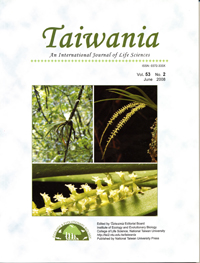Research Paper
Comparative Studies on Community Ecology of Two Types of Subtropical Forests Grown in Silicate and Limestone Habitats in the Northern Part of Okinawa Island, Japan
S. M. Feroz and A. Hagihara
Published on: June 2008
Page: 134 - 149
DOI: 10.6165/tai.2008.53(2).134
Abstract
In order to compare woody species diversity, spatial distribution of trees and stand structure on the basis of the architectural stratification between two types of subtropical forests in the northern part of Okinawa Island, Japan, tree censuses in a 750 m2 plot in silicate habitat and a 1000 m2 plot in limestone habitat were performed. It was found that both subtropical forests growing in silicate and limestone habitats consisted of four architectural layers. A total of 26 families, 43 genera, 60 species and 4684 individuals larger than 0.1 m high in the silicate habitat, and 31 families, 51 genera, 62 species and 4798 individuals larger than 0.0 m high in the limestone habitat, were recorded. As a result, the floristic composition in the silicate habitat was quite different from that in the limestone habitat in terms of similarity index ( Π C = 0.07); approximately only one-sixth of the species were in common. The floristic composition among layers was more similar in the silicate habitat than in the limestone habitat. Castanopsis sieboldii (Mak.) Hatusima was the most dominant species in the silicate habitat, but was completely absent in the limestone habitat where Cinnamomum japonicum Sieb. ex Nees was the most dominant species. The potential number of species in the silicate forest (62) was lower than that in the limestone forest (71). However, the woody species diversity was higher in the silicate forest than in the limestone forest. The values of H′ and J′ tended to increase from the top layer downward except for the bottom layer in the silicate forest, while this increasing trend was reversed in the limestone forest. It follows that high woody species diversity in the silicate forest depended on small-sized trees, whereas in the limestone forest it depended on big-sized trees. The spatial distribution of trees in the forests was random in each layer, except the top layer, where there existed a double-clump structure. High degree of overlapping in the spatial distribution of trees among layers suggested that light can not penetrate easily to the lower layers, so that understory trees might be shade-tolerant species. Mean tree weight decreased from the top toward the bottom layer, whereas tree density increased from the top downward. It was concluded that this trend was general in both of the forests, and this trend successfully expressed in the same form as in the mean weight-density trajectory of self-thinning plant populations.
中文摘要
本研究探討兩亞熱帶森林的森林結構,以及在不同垂直分層中木本植物歧異度和空間分佈之特性。調查區域位於日本沖繩島北方,為生長在矽酸岩及石灰岩生育地上之森林,調查樣區大小分別為750 及1000 平方公尺。結果顯示,兩森林中之垂直結構皆可分成四層。於矽酸岩生育地樣區中,總計有4684 株高度高於0.1 公尺之個體,分屬26 科,43 屬及60 種。於石灰岩生育地樣區中,則總計有4798 株高度高於0.0 公尺之個體,分屬31 科,51 屬及62 種。兩樣區之植物組成相似度很低( Π C = 0.07),只有約六分之ㄧ的物種為兩樣區所共有。比較各垂直分層間的組成時,矽酸岩樣區層次間的物種相似性較高,而石灰岩樣區則較低。在矽酸岩樣區中最優勢的物種為Castanopsis sieboldii (Mak.) Hatusima,但此物種於石灰岩樣區中完全闕如。於石灰岩樣區中的最優勢物種為Cinnamomum japonicum Sieb. ex Nees。比較兩樣區中的潛在物種數目時,矽酸岩樣區的值(62)較低於石灰岩樣區中的潛在數目(71)。然而,木本植物歧異度則於矽酸岩樣區中較高。當比較層次間的歧異度指數( H ′ 及 J ′ 值)時,其值於矽酸岩樣區為從樹冠層往底層漸次增加(除了最低的地被層稍有降低),而在石灰岩樣區中,歧異度指數值的增加方向恰為相反。此結果表示,矽酸岩樣區中的高物種歧異度,主要取決於小徑級的個體,而石灰岩樣區中的物種歧異度,主要取決於大徑級的個體。植株數於各樹冠層次間的空間分布上,多屬於隨機分布,除了樹冠層的植株數於兩個空間尺度上有聚集的現象。在此兩樣區中,各層次的個體在空間上具有高度重疊性,顯示了光度無法輕易到達森林下層,所以下層組成可能多為耐陰物種。兩樣區中平均植株的重量 (直徑和高度的函數) 為由森林上層往下層減輕,但是植株密度則由上層往下層增加。本研究顯示了此結構為兩樣區森林所共有之特性,而此特性符合在平均植株重量與密度分析中的自我疏伐模式。
Keyword: Architectural stratification, floristic similarity, limestone habitat, mean tree weight-density relationship, Okinawa Island, silicate habitat, spatial distribution of trees, Subtropical forest, woody


